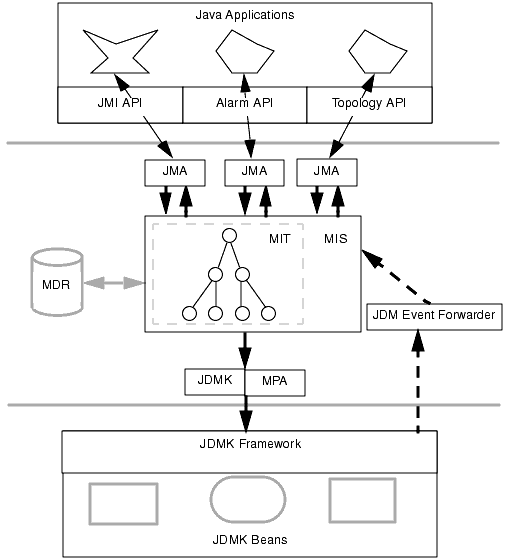| Solstice Enterprise Manager 4.1 Developing Java Applications |
Introduction
This chapter provides an overview of the Java development tools and associated infrastructure that enables you to create Java applications and manage Java Dynamic Management Kit (JDMK) agents with Solstice Enterprise Manager (Solstice EM).
This chapter covers the following topics:
- Section 1.1 Important Terms
- Section 1.2 Architectural Overview
- Section 1.3 Java APIs
- Section 1.4 JDMK MPA
- Section 1.5 JDMK to CMIS Event Forwarder
- Section 1.6 JMA
1.1 Important Terms
The following table lists terms that are used in this book.
1.2 Architectural Overview
Before starting to develop Java applications with Solstice EM, it is important for you to understand how the Java components required to do the job relate to the Management Information Server (MIS) architecture; as illustrated in the following figure.

FIGURE 1-1 Architectural OverviewAs you can see in FIGURE 1-1, there are two main components for developing Java solutions with Solstice EM:
- The Java API environment consisting of the JMI API, Alarm API, and Topology API
- Allows you to develop Java applications that can interact with the MIS transparently.
- JDMK
- Allows you to build agents.
These two development components are supported by other "adaptor" components that allow Java and C++ Solstice EM applications, JDMK agents, and other types of agents to communicate seamlessly through the MIS.
Note – The Java APIs and associated tools of Solstice EM require the Java 2 SDK. Earlier versions of the Java Development Kit are not compatible with Solstice EM.
1.3 Java APIs
The JMI API, Alarm API, and Topology APIs allow you to develop low-cost, multi-platform Java applications to help manage your network. These applications take full advantage of the advanced distributed management services provided by Solstice EM.
These APIs follow the thin class paradigm. They delegate the bulk of their implementation to a more powerful server. Class state and cache data are located on the server to minimize memory usage by the client.
In addition, it is totally transparent to the user whether a method of a class in these APIs is executed locally or remotely. As a result, you can continue to use these classes in the same manner as any other programming language, like C++.
For example, if you instantiate the Platform class, some of the methods in this class would be executed locally, while other methods would be executed on a corresponding remote class or object present on a JMA server.
The Java APIs and associated infrastructure are optimized for efficiency and performance based on the application processing requirements and available resources. For example:
- Memory or CPU intensive operations occur on the server transparently.
- Both the Topology and Alarm APIs provide methods to enable the batch-loading of records, which improves the responsiveness of the client.
- Class state and cache data are located on the server to minimize memory usage by the client.
1.4 JDMK MPA
The JDMK Management Protocol Adapter (MPA) maps Common Management Information Service (CMIS) requests into JavaBeans JDMK calls. The JDMK MPA allows Java applications to access JavaBeans components through JDMK as GDMO objects. However, the JDMK MPA does not allow Java objects to make CMIS requests back into the MIS. You can only make such requests through the JMI API. A JDMK agent can send M-Events to the MIS through the JDMK to CMIS Event listener, which routes events through the JDM Event component. (See FIGURE 1-1.)
1.5 JDMK to CMIS Event Forwarder
The JDMK to CMIS Event listener is a daemon process that converts JDMK JavaBean events to Solstice EM CMIS notifications. JDMK agents can send events through the JDMK event mechanism that translates them into Solstice EM CMIS notifications. The type of notification generated is handled transparently as part of the JavaBean to GDMO tool. Any JavaBean that implements the addXXXListener and removeXXXListener classes causes the JavaBean to GDMO tool to generate an XXX notification type.
1.6 JMA
The Java Management Adapter (JMA) provides the framework for the thin client/fat server model. JMA is not exposed to end users or developers. It is a transparent component lying between services such as the JMI and the MIS.
JMA provides the infrastructure for services such as JMI API, Topology API, and Alarm API to communicate seamlessly with the MIS. It is responsible for the scheduling and synchronization of all PMI calls made by each Java API. It provides an event handling mechanism, which allows clients to register their own events and servers to forward the events to the clients.
|
Sun Microsystems, Inc. Copyright information. All rights reserved. |
Doc Set | Contents | Previous | Next | Index |